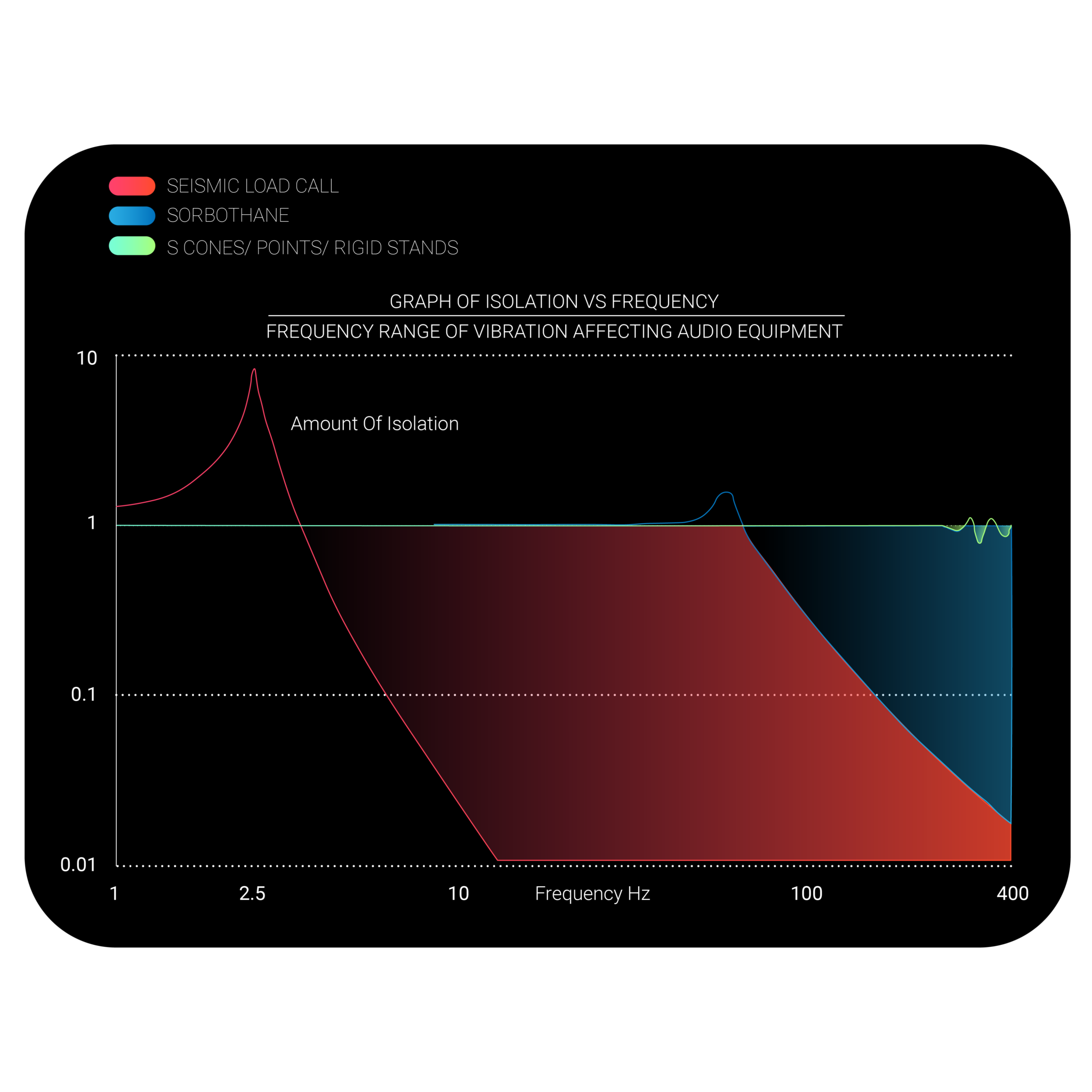Earthquakes on hifi
Unwanted Vibrations in Audio
Any group of components brought together with the aim of accurately reproducing music or a film soundtrack is at the mercy of our planet, and the consequences truly are seismic.
Global activity occurs every moment of the day and night, mostly manifested as microtremors. These ground-borne seismic vibrations are always present, everywhere, and at all times.
They are Mother Earth’s never-ending backing track, the residual noise recorded on seismographs between earthquakes. Unless filtered out, the microtremors join in and wash away crucial fine detail.
So how come we can’t feel them?
Their amplitude is very low, measuring between force -1 and force 2 on The Richter Scale, shown in any seismograph reading. No, you can’t feel them and the only way you can see them is as a graphic trace. But you can hear their degrading influence.
The presence of low-level seismic activity 24/7 is responsible for undermining your hi-fi’s potential to give true musical satisfaction and ultimately
compromises your financial investment in whatever hardware you choose to own.
Townshend Audio is the world’s only manufacturer of isolation systems that protect hi-fi and AV equipment from seismic microtremors. The first line of defence is the Seismic Podium. Designed as a range to accommodate any size and weight of speaker – stand-mount plus stand, floor-stander or subwoofer – the Seismic Podium breaks the acoustic connection between the floor and the speaker, preventing the passage of deleterious vibrations both to
and from the speaker cabinets.
For a detailed explanation of why this is an absolute necessity before any speaker can perform to its true potential, read ‘Earthquakes on hi-fi’ on Seismic Isolation Podiums, speakers are freed from the ever-present seismic activity and room/floor interactions that seriously degrade sound quality. The result is simply magical, allowing listeners to hear into their favourite music in a way they were never able to previously. When under your speakers, they will give you immediate improvements in overall sound by preventing speaker generated vibration from entering the floor and
sound from entering your speakers. By eliminating the resonance between the speaker-cabinet mass and the floor, the sound will be noticeably clearer, much more tuneful, controlled and natural.
Bass boom is significantly reduced and there will be a far larger, much deeper and wider sound stage. The sound becomes natural and more enjoyable.
As many have already witnessed, the improvements are a revelation and a true pleasure – not least because
severing the acoustic link between the speaker and the floor allows playback at more realistic volume levels
without annoying the neighbours!
There is an earthquake under our feet 24/7. The amplitude is very low, measuring between force -1 and force 2 on The Richter Scale, as shown (fig. 1)
Fig 1)
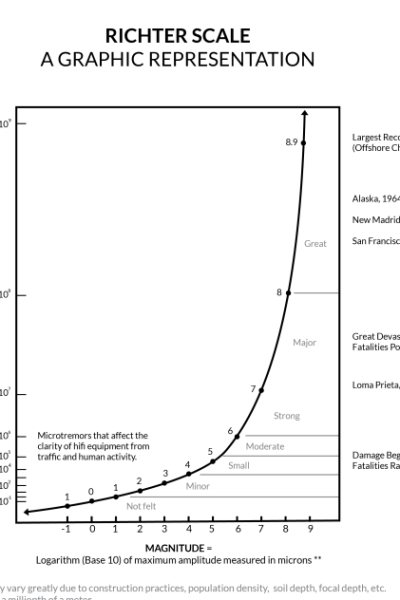
Fig 2)
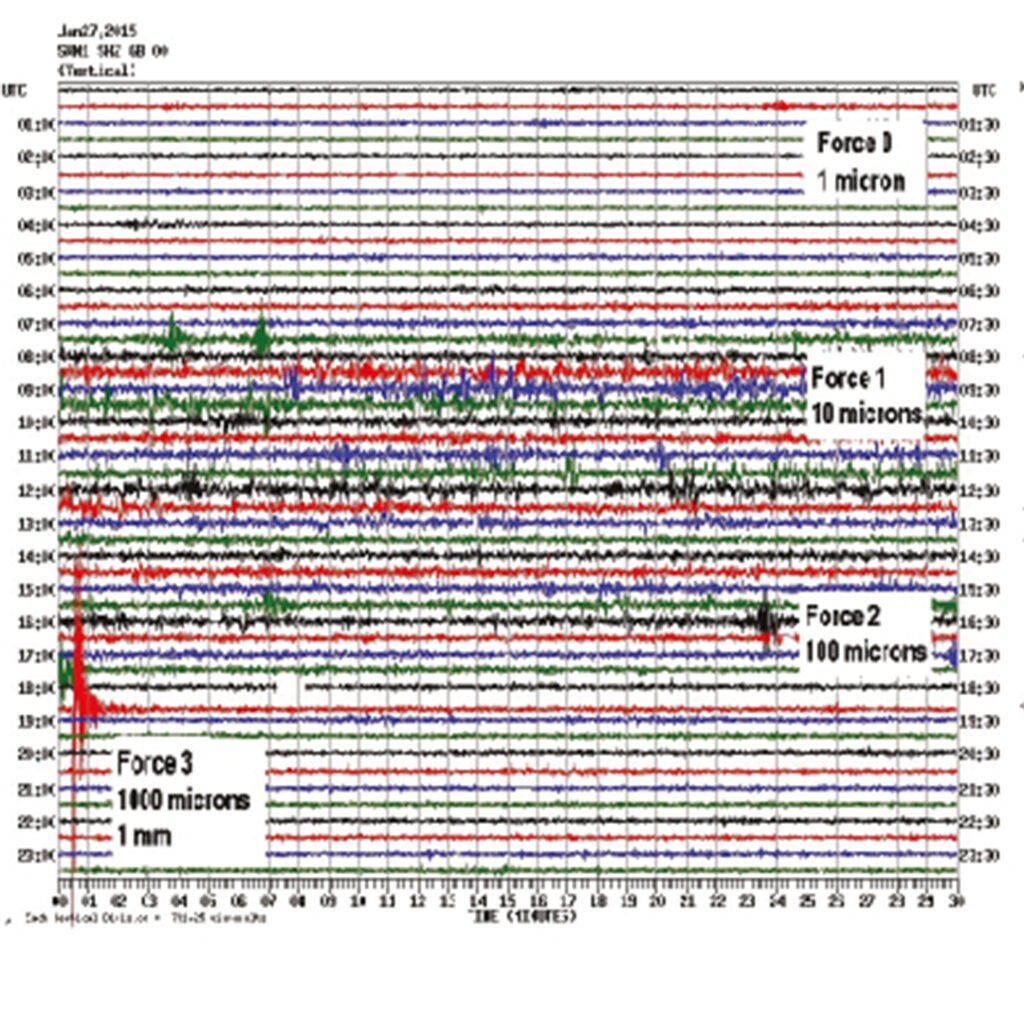
This means that most living room floors will be vibrating with an amplitude of about 10 microns (force 1) with a frequency range from 1—500 Hz.from the US Geological Survey. These tremors are the result of myriad worldwide earthquakes shaking the ground at such low amplitude, they are not felt. The amplitude of these earthquakes in built up areas varies through the day due to man-made disturbances and natural phenomena, such as wind and tide. For example, The Houses of Parliament rise and fall 11” twice a day due to the rise and fall of the Thames. The result of these vibrations is shown in the Seismograph read-out (fig. 2), which is from The British Geological Survey
Seismograph, measured in Swindon, England, on the 27 January 2015.
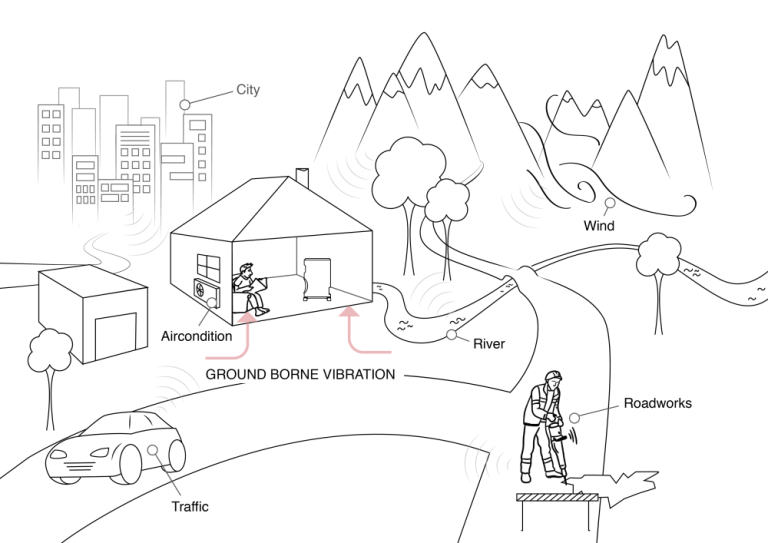
Notice how quiet things are between 8PM and 5AM. Then the increase in amplitude,
commencing at around 5.30 AM, caused by the build-up of traffic on the nearby M4 motorway. As the traffic builds and human activity increases, the noise increases quite dramatically.
The range is from force 0 to force 2 and is typical of most built up areas throughout the world. Clock the force 3 natural earthquake at 6.30PM! To see more of these read-outs, look up “live seismograph data”.
This means that most living room floors will be vibrating with an amplitude of about 10 microns (force 1) with a frequency range from 1—500 Hz. The closer noise sources result in higher frequency vibration.
The speaker (fig. 3) has an upper mid-band 5kHz signal, level 40dB at 1 metre applied. This is representative of the level of sound from a decaying cymbal note. The resultant cone move- ment of a 100mm diameter driver, is about 0.01 microns. If the speaker is coupled rigidly to the floor with spikes, the 10 micron earthquake floor vibration will travel up the spikes, into the cabinet, into the basket and onto the magnet plate. As the magnet plate is the “launch-pad” of your audio signal, this seismic movement will be superimposed onto your music (10/0.01=1000 times greater!) inevitably contaminating it.
Fig 3)
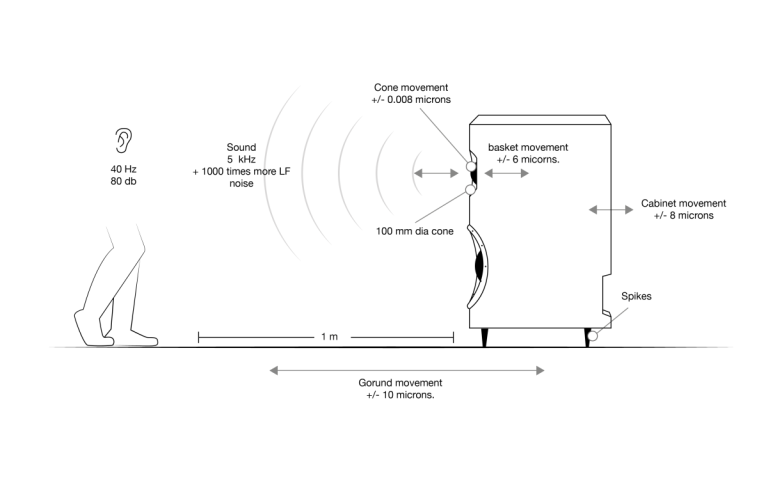
Fig 4)
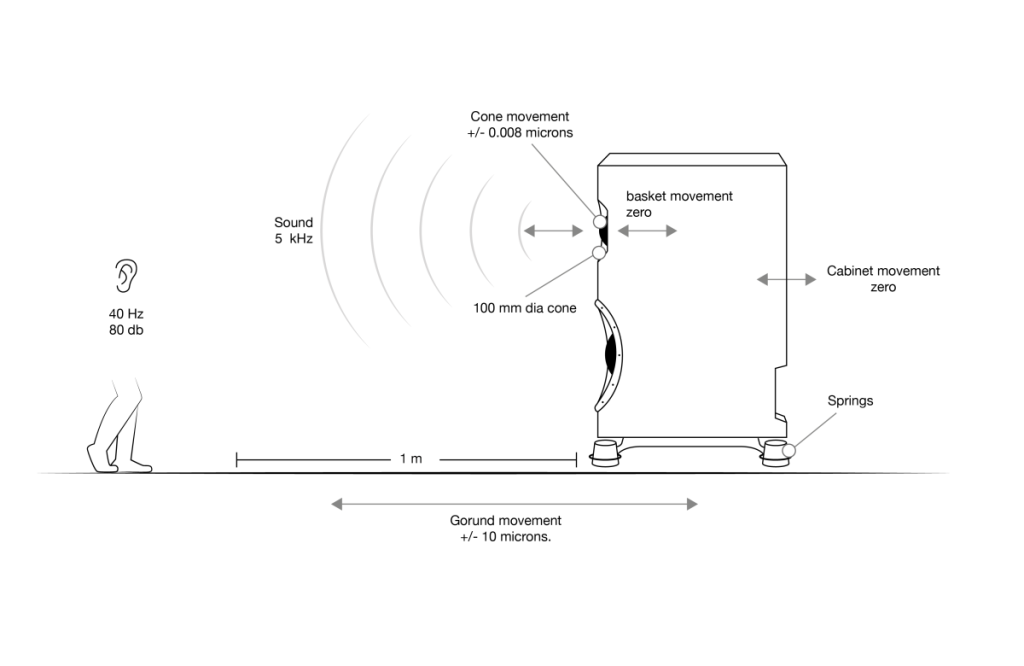
Replacing spikes with Townshend Audio (TA) Seismic Isolation, dramatically reduces the ground borne vibration entering the speaker, so that only the music is heard (fig. 4) Seismic Isolation will break the connection between your speaker and the floor with a subsequent increase in clarity, depth and soundstage.
Seismic Isolation will break the connection between your speaker and the floor with a subsequent increase in clarity, depth and soundstage.
Fig 5)
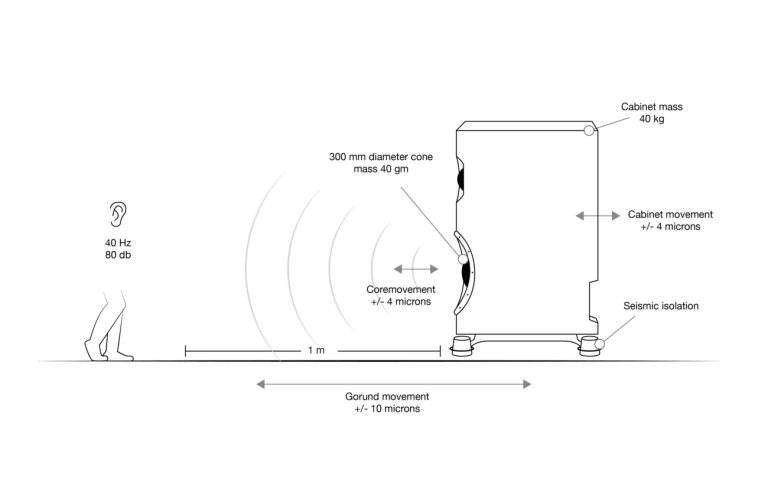
When the cabinet is Seismically suspended, at the lower end of the spectrum, a bass note of 41Hz (E1) at 80dB level, at 1m is reproduced by a 300 mm (12”) driver, the cone movement will be 4mm. If the mass of the cone is 40g and the mass of the cabinet is 40kg, the cabinet movement will be 4 microns. (fig. 5)
By Newton’s Third Law, the 4 micron cabinet movement will be linearly related to the 4mm cone movement, causing no distortion. This will only decrease the bass output by a miniscule 0.01%. If the speaker is rigidly spiked to the floor, then the 10 micron floor noise will be added to the 4 micron driver movement, causing more problems than it solves! Further, the resultant bass noise (boom) will be transmitted into the floor, where it will re-radiates into the listening room and all adjacent rooms. (fig. 6)
By Newton’s Third Law, the 4 micron cabinet movement will be linearly related to the 4mm cone movement, causing no distortion. This will only decrease the bass output by a miniscule 0.01%.
If the speaker is rigidly spiked to the floor, then the 10 micron floor noise will be added to the 4 micron driver movement, causing more problems
than it solves! Further, the resultant bass noise (boom) will be transmitted into the floor,
where it will re-radiates into the listening room and all adjacent rooms.
(fig. 6)
With Seismic Speaker Isolation this insidious path is blocked, so you can enjoy your much more musical system without disturbing the neighbours. For the last 25 years, TA has promoted the radical concept of very low frequency vibration Isolation of all hi-fi components, including speakers. With the extensive experience gained and the in-depth understanding of real life situations, TA has engineered a compre- hensive range of products to ensure the optimum performance and enjoyment of any hi-fi system.
Fig 6)
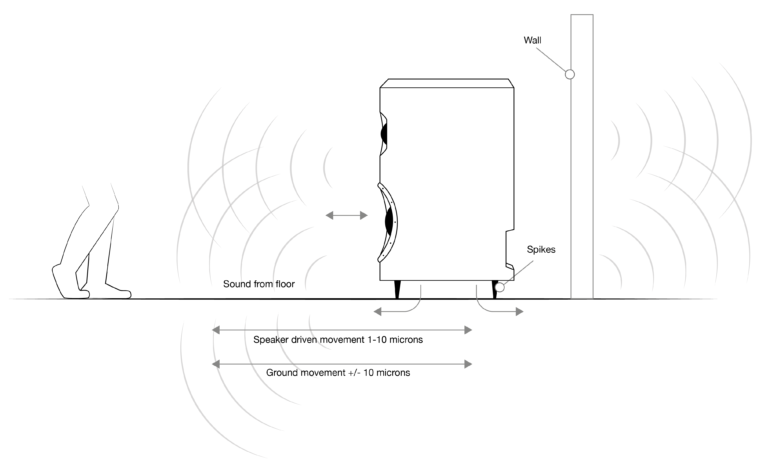
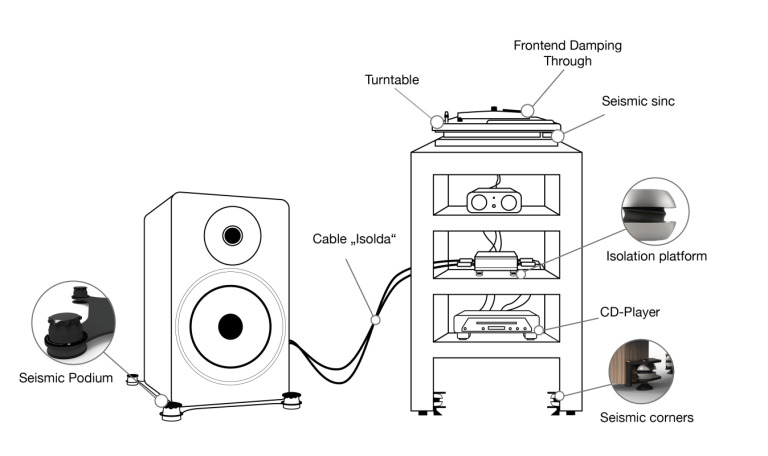
The Townshend ‘Floating Effect’ will free every note allowing accurate attack and decay of each musical note- simply magical
Resonant Frequency vs Deflection
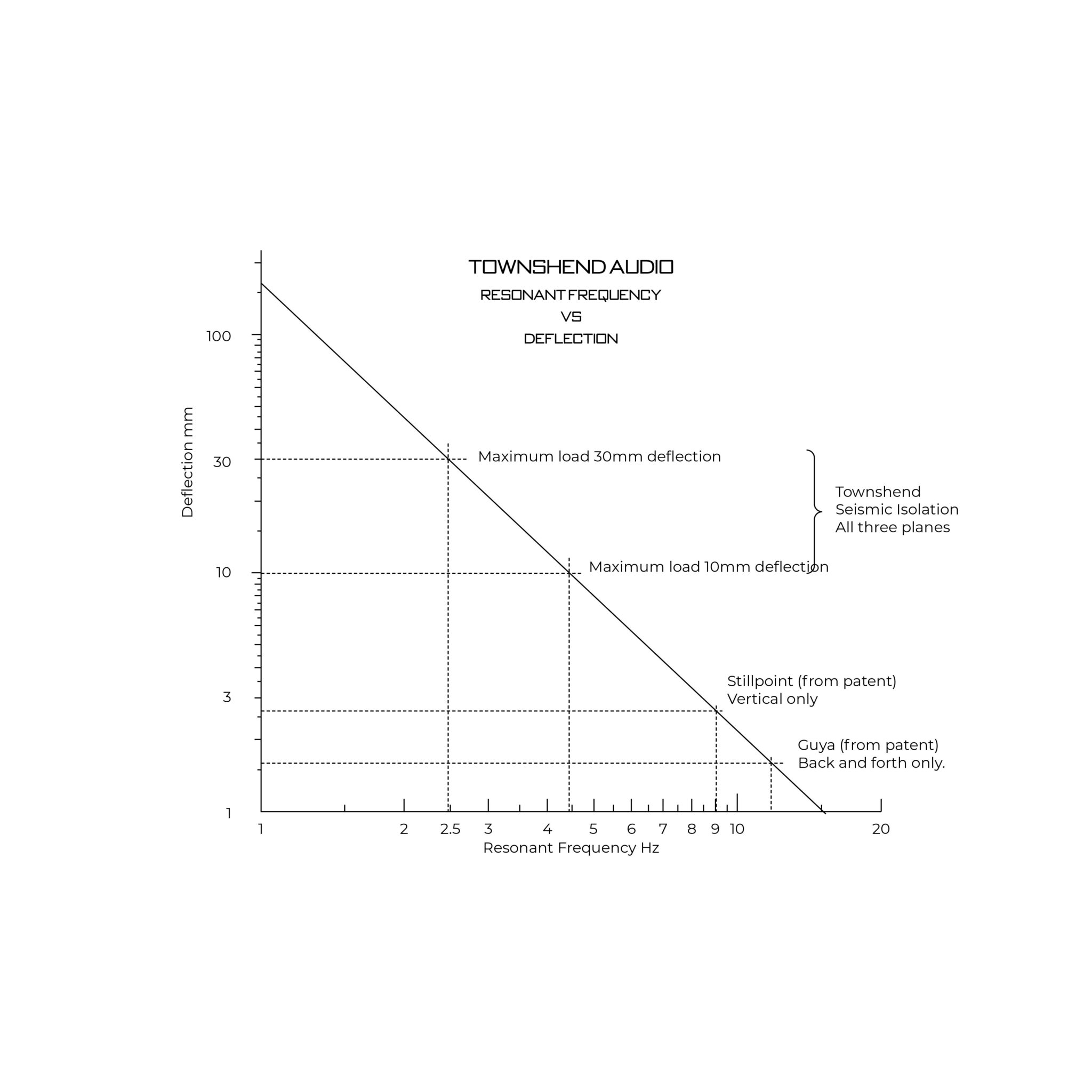
When describing the relationship between deflection and frequency on a graph, particularly in the context of vibration or resonance analysis the graph typically plots frequency on the horizontal axis (x-axis) and deflection (or displacement amplitude) on the vertical axis (y-axis).
Key Features of the Deflection vs. Frequency Graph:
- Low-Frequency Region:
- At lower frequencies, the deflection of the system typically remains moderate.
- This region shows a gradual rise in deflection as the frequency increases.
- Resonant Frequency (Peak):
- At a certain frequency known as the resonant frequency, the deflection reaches its maximum. This is often represented by a sharp peak in the graph.
- The system experiences the highest deflection due to resonance, where the natural frequency of the system aligns with the driving frequency.
- The peak is typically very sharp for lightly damped systems, while more damped systems have a broader and lower peak.
- Post-Resonance Region (High Frequencies):
- After passing the resonant frequency, the deflection begins to decrease rapidly as the frequency continues to rise.
- The graph shows a steep decline in deflection at higher frequencies because the system becomes less responsive to vibrations at those frequencies.
Assertions about using spikes.
By Jack Dinsdale, Professor of Mechatronics
If, and this is a very big IF because it is impossible practically, every item in the sound reproducing chain from front end to speakers was connected (spiked) by infinitely stiff means to an infinitely stiff, perfectly (100%) damped, infinitely stiff infinite mass which was perfectly (100%) damped and not vibrating in any way, then spiking would work. This is clearly impossible, but it might explain how spiking came into vogue in the 1950s, when folk had no idea about stiffness (lack of), damping (lack of) and how buildings and the earth itself are anything but perfect.
The only logical practical alternative is to isolate each item, which is what we do with your various mounts. It could be argued that our system ‘spikes each item to the atmosphere (void)’ which is effectively perfectly (100%) damped and (almost) perfectly isolates them from each other
Transmissibility
Ideally, you would like to enjoy your music at its natural volume level—as if you were listening to a live performance—without being irritated by vibrations caused by other building equipment or annoying the neighbours!
The Transmissibility graph shows the ways vibration is attenuated at different frequencies.
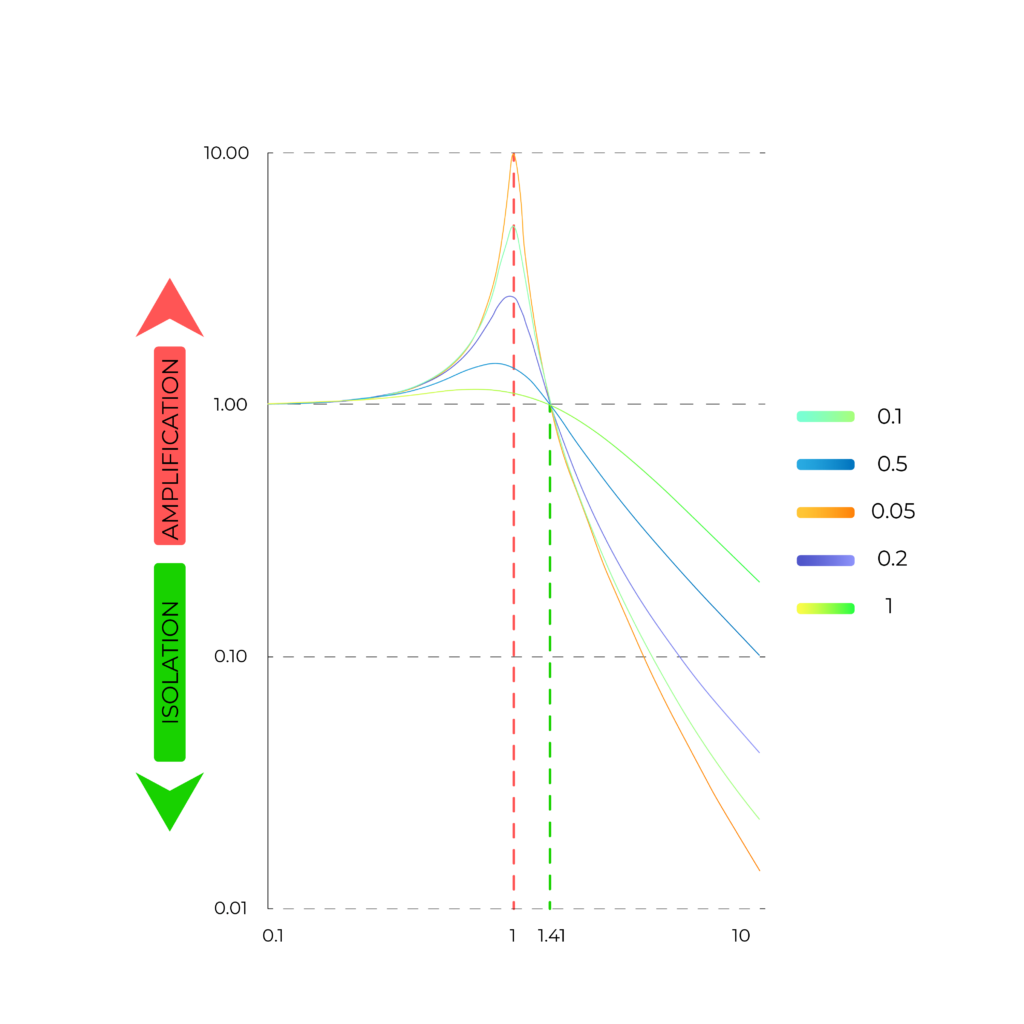
Conventional so-called rigid supports (spikes or cones) aim to hold the speaker cabinet ‘still’ at audio frequencies. However, there will be a resonance set up by the mass of the cabinet reacting with the unavoidable springiness of the floor, even concrete floors. This can cause vibration of the whole building structure in the audio band, which can be very audible to your neighbours. This ‘rigid coupling’ is shown by the black line in the transmissibility graph – a transmissibility of 1. Rigid coupling also transmits building-borne vibration back into the speaker cabinet and thence to the speaker driver baskets where it is superimposed onto your own music and also into other components in your audio system.
The solution is to isolate your speakers from the building structure using a low-pass filter, in other words to let them ‘float’ throughout the audio waveband. This can be achieved by using Townshend Seismic Load Cells.
They work by coupling the mass of the speaker cabinet to the building structure, usually the floor, via a spring. At very low frequencies, the supported mass (speaker cabinet) follows the (slow) movement of the floor with a transmissibility of 1, just as with the rigid coupling. As the frequency of movement of the speaker cabinet (caused by reaction to the movement of the speech coil as it plays music) rises, a point of resonance is reached where it oscillates a large amount for a small input, 3.5Hz in the example in the graph. This large resonant oscillation can be tamed by damping. As the frequency rises further, the movement of the speaker cabinet reduces, ultimately at a rate of 12dB per octave, the orange line in the transmissibility graph. For audio systems, this reduction in coupling between the speaker cabinet and the building structure should start at about 5Hz. This resonant frequency of oscillation depends on the mass and spring rate, but it can be shown to be 3.5Hz if the compression of the spring when loaded is about 30mm. In this way a spring can be selected for any speaker cabinet to give a resonant frequency of 3.5Hz.
Since Seismic Load Cells are bi-directional they also reduce the effects of building structure vibration from entering your speakers. Furthermore, they act equally in all three planes, thus counteracting all aspects of building structure vibration.
For large displacements and without any damping, the speaker cabinet would oscillate for quite a long period, as is common with undamped sprung turntables. In the Seismic Load Cell this oscillation is rapidly damped by the turbulence of the air passing through the hole in the bellows/small-hole resistive damping arrangement, as shown by the dotted orange line. When at rest there is no resistance, and full isolation performance is realized. The orange shaded area in the graph shows the high level of isolation achieved by using Seismic Load Cells, compared with that from spikes and cones.
As a listener, you experience the Townshend Floating Effect – the sound improves dramatically and becomes independent of the speakers, providing wider stage width and greater depth, together with tighter and more realistic bass, thuddy boom now eliminated. You will be able to enjoy your music at its natural volume level – as if you were listening to a live performance – without annoying the neighbours!
Rigid devices such as cones and spikes do not isolate, they couple. Springs made of rubber compounds, such as Sorbothane, are partially successful, but they don’t act as springs at frequencies below about 50Hz. Much of the musical energy which can stimulate vibration of the building structure is contained at lower frequencies, at which these compound springs act effectively as couplings with a transmissibility of 1, as shown by the green line on the transmissibility graph. The effectiveness of Sorbothane speaker mounts, shown as the green dotted area on the graph, is thus severely limited. Magnetic repulsion ‘spring’ mounts are only partly successful because they cannot operate in all three planes without some form of mechanical restraint (Earnshaw’s theorem), which detracts from their effectiveness. Unlike these and all spikes and cones, Townshend Seismic Load Cells act equally in all three planes.
Comparison of Isolation Effectiveness: Townshend Seismic Isolation vs. Alternative Control Approaches
